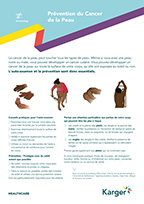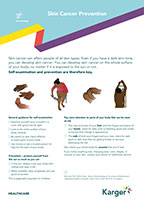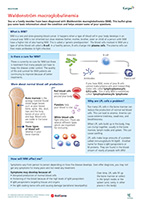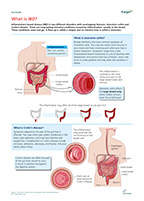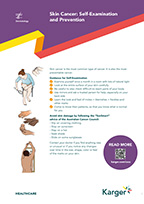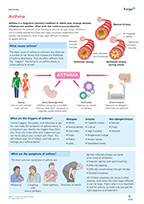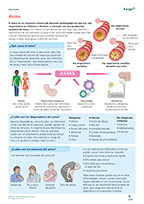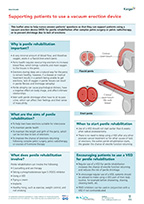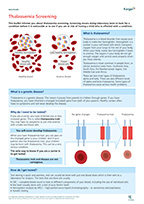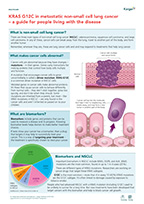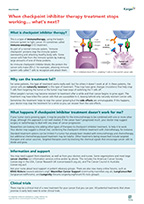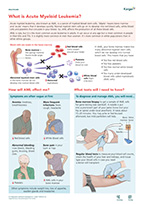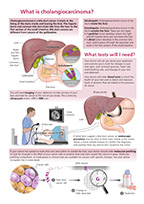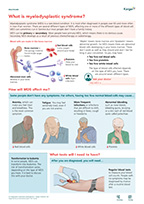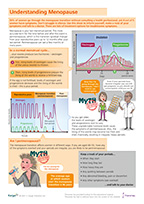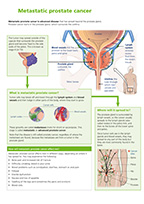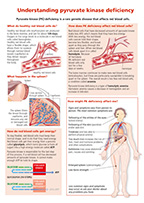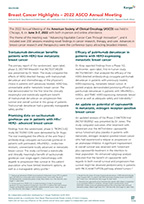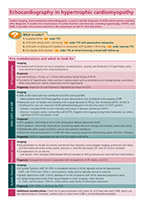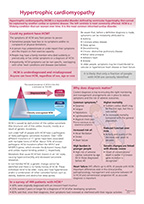Summary Sheets
Short, concise 2-page summary sheets on a specific topic in medicine.
Search Titles
Language
Audience
Subject Areas
Urogenital Atrophy
Urogenital atrophy (UGA) is a condition caused by a drop in the level of oestrogen.
(PDF 360 KB)
Prévention du Cancer de la Peau Noire
Le cancer de la peau peut toucher tous les types de peau.
(PDF 338 KB)
Skin Cancer Prevention for Dark Skin
Skin cancer can affect people of all skin types. Even if you have a dark skin tone, you can develop skin cancer.
(PDF 192 KB)
Chronic Lymphocytic Leukemia
You or a family member have been diagnosed with chronic lymphocytic leukemia (CLL). This leaflet gives you some basic information about the condition and may help answer some of your questions.
(PDF 1,2 MB)
Hautkrebs: Selbstuntersuchung und Prävention
Hautkrebs ist die häufigste und zugleich am meisten vermeidbare Krebsart. Anleitung zur Selbstuntersuchung und Ratschläge zur Vermeidung von Hautschäden.
(PDF 365 KB)
Waldenström macroglobulinemia
You or a family member have been diagnosed with Waldenström macroglobulinemia (WM). This leaflet gives you some basic information about the condition and helps answer some of your questions.
(PDF 2,2 MB)
What is IBD?
Inflammatory bowel disease (IBD) is two different disorders with overlapping features: ulcerative colitis and Crohn’s disease.
(PDF 4,8 MB)
Skin Cancer: Self-Examination and Prevention
Skin cancer is the most common type of cancer. It is also the most preventable cancer.
(PDF 275 KB)
Supporting Patients to Use a Vacuum Erection Device
This leaflet aims to help nurses answer patients’ questions so that they can support patients using a vacuum erection device (VED) for penile rehabilitation after complex pelvic surgery or pelvic radiotherapy, or to prevent shrinkage due to lack of erections.
(PDF 7,5 MB)
Alpha Thalassemia
You or a family member have been diagnosed with alpha thalassemia (AT). This leaflet will give you some basic information about the condition and help answer some of your questions.
(PDF 3 MB)
Beta Thalassemia
You or a family member have been diagnosed with beta thalassemia (BT). This leaflet will give you some basic information about the condition and help answer some of your questions.
(PDF 3 MB)
Thalassemia Screening
This leaflet informs you about thalassemia screening. Screening means doing laboratory tests to look for a condition before it is noticeable or to see if you are at risk of having a child who is affected with a condition.
(PDF 2,6 MB)
KRAS G12C in Metastatic Non-Small Cell Lung Cancer
There are three main types of non-small cell lung cancer (NSCLC): adenocarcinoma, squamous cell carcinoma, and large cell carcinoma. In any of these, cancer cells can break away from the lung, travel to another part of the body, and form another tumor.
(PDF 7 MB)
When Checkpoint Inhibitor Therapy Stops Working
This is a type of immunotherapy, using the body’s immune system to fight cancer. It’s sometimes called immuno-oncology (I-O) treatment.
(PDF 5,8 MB)
Biomarkers in Metastatic Non-Small Cell Lung Cancer
Cancers are named after the type of cell that becomes cancerous. There are many different cell types in the lungs, so there is more than one type of lung cancer.
(PDF 6,6 MB)
What is Acute Myeloid Leukemia?
Acute myeloid leukemia, also known as AML, is a cancer of myeloid blood stem cells. ‘Myelo’ means bone marrow and ‘acute’ means that it develops quickly. Normal myeloid stem cells go on to develop into red blood cells, white blood cells and platelets that circulate in your blood. So, AML affects the production of all these blood cells.
(PDF 7,3 MB)
What is Cholangiocarcinoma?
Cholangiocarcinoma is a bile duct cancer. It starts in the lining of the ducts inside and leaving the liver. The hepatic ducts and common bile duct drain bile from the liver to the first section of the small intestine. Bile duct cancers are different from cancers of the gallbladder.
(PDF 12,6 MB)
What is Myelodysplastic Syndrome?
Myelodysplastic syndrome (MDS) is a rare blood condition. It is most often diagnosed in people over 65 and more often in men than women. There are several different types of MDS, affecting one or more of the different types of blood cell. MDS can sometimes run in families but most people don’t have a family history.
(PDF 6,2 MB)
Understanding Menopause
50% of women go through the menopause transition without consulting a health professional, yet 4 out of 5 women have symptoms. Don’t struggle in silence. Use this sheet to inform yourself, make a note of your symptoms and talk to a doctor. There are lots of treatment options for troublesome symptoms.
(PDF 3,4 MB)
Metastatic Prostate Cancer
Metastatic prostate cancer is advanced disease that has spread beyond the prostate gland. Prostate cancer starts in the prostate gland, which surrounds the urethra.
(PDF 1,7 MB)
Myeloma: Cancer of the Immune System
Myeloma is a cancer of the plasma cells, a type of white blood cell that resides in the bone marrow.
(PDF 4,8 MB)
Understanding Pyruvate Kinase Deficiency
Pyruvate kinase (PK) deficiency is a rare genetic disease that affects red blood cells.
(PDF 4,8 MB)
Staging of Prostate Cancer
The prostate gland is below the bladder. It surrounds the urethra – the tube that carries urine from the bladder to the penis.
(PDF 7,3 MB)
Colorectal Cancer Highlights – 2022 ESMO Annual Meeting
A total of 1,912 abstracts presenting the latest advances in cancer treatment were presented at the congress.
(PDF 119 KB)
Breast Cancer Highlights - 2022 ASCO Annual Meeting
Advances in breast cancer research and therapeutics were the conference topics attracting broadest interest.
(PDF 93 KB)
Echocardiography in Hypertrophic Cardiomyopathy
Cardiac imaging, most commonly echocardiography, is used to aid the diagnosis of HCM and to monitor patients after diagnosis.
(PDF 5,6 MB)
Hypertrophic Cardiomyopathy
Hypertrophic cardiomyopathy (HCM) is a myocardial disorder defined by ventricular hypertrophy that cannot be explained by another cardiac or systemic disease.
(PDF 6,5 MB)


